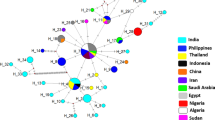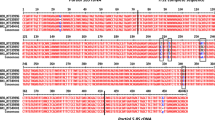Abstract
Background
Trypanosoma evansi is a protozoan parasite that can infect a wide range of animals and is widespread around the world. In this study, we analyzed four fatal cases of T. evansi infection using clinical, parasitological, and molecular approaches. We also explored the genetic diversity, demographic history, and population-genetic structure of T. evansi using available Rode Trypanozoon antigenic type (RoTat) 1.2 gene sequences.
Methods and results
Clinical findings of infected animals revealed high fever, anemia, weakness, and anorexia. The animals were treated with diminazene aceturate, which was moderately effective, and hematobiochemical parameters showed changes in hemoglobin and glucose levels. The molecular and genetic diversity of T. evansi was analyzed using the RoTat 1.2 VSG gene. Phylogenetic and haplotype analysis revealed two distinct clusters of T. evansi circulating in India. The genetic diversity indices, neutrality tests, gene flow, and genetic differentiation outcomes confirmed the genetic diversity of the T. evansi population, with a lack of uniformity. The identification of two distinct clusters, exhibiting differential demographic histories and evolutionary forces, implies that the clusters may have undergone independent evolutionary trajectories or experienced different environmental pressures.
Conclusion
The present findings underlined the need of an early and precise diagnosis in order to treat and control T. evansi infections, and the RoTat 1.2 VSG gene is an important genetic marker for understanding the genetic diversity and evolutionary history of T. evansi. This knowledge can be used to create tailored strategies to control and manage the infection in an endemic region.




Similar content being viewed by others
Data Availability
The data used to support the findings of this study are available within the manuscript and its supplementary material.
References
Aregawi WG, Agga GE, Abdi RD, Büscher P (2019) Systematic review and meta-analysis on the global distribution, host range, and prevalence of Trypanosoma evansi. Parasit Vectors 2:1–25. https://doi.10.1186/S13071-019-3311-4
Sangeetha SG, Nehra AK, Raguvaran R, Banerjee PS, Ram H (2022) Oral transmission of Trypanosoma evansi infection in a german shepherd dog—a rare case report. Comp Clin Pathol 31:175–179. https://doi.org/10.1007/s00580-022-03324-6
Kumar R, Gupta S, Bhutia WD, Vaid RK, Kumar S (2022) Atypical human trypanosomosis: potentially emerging disease with lack of understanding. Zoonoses Public Health 69:259–276. https://doi.org/10.1111/zph.12945
Sengupta PP, Jacob SS, Chandu AG, Das S (2022) Silent Trypanosoma evansi infection in humans from India revealed by serological and molecular surveys, and characterized by variable surface glycoprotein gene sequences. Acta Trop 229:106369. https://doi.org/10.1016/j.actatropica.2022.106369
Pathak KM, Chhabra MB (2011) Trypanosomosis of livestock in India: a review of two decades. Indian J Anim Sci 81:653–660
Kumar R, Jain S, Kumar S, Sethi K, Kumar S, Tripathi BN (2017) Impact estimation of animal trypanosomosis (surra) on livestock productivity in India using simulation model: current and future perspective. Vet Parasitol Reg Stud Rep 10:1–2. https://doi.org/10.1016/j.vprsr.2017.06.008
Medkour H, Varloud M, Davoust B, Mediannikov O (2020) New molecular approach for the detection of kinetoplastida parasites of medical and veterinary interest. Microorganisms 8:356. https://doi.org/10.3390/microorganisms8030356
Sengupta PP, Balumahendiran M, Suryanaryana VV, Raghavendra AG, Shome BR, Gajendragad MR, Prabhudas K (2010) PCR-based diagnosis of surra-targeting VSG gene: experimental studies in small laboratory rodents and buffalo. Vet Parasitol 171:22–31. https://doi.org/10.1016/j.vetpar.2010.03.011
Kumar R, Sarkhel SP, Kumar S, Batra K, Sethi K, Jain S, Kumar S, Tripathi BN (2019) Molecular characterization and phylogenetic analysis of Trypanosoma evansi from Northern India based on 18S ribosomal gene. Vet Parasitol Reg Stud Rep 15:100259. https://doi.org/10.1016/j.vprsr.2018.100259
Pourjafar M, Badiei K, Sharifiyazdi H, Chalmeh A, Naghib M, Babazadeh M, Mootabi Alavi A, Hosseini Joshani-zadeh N (2013) Genetic characterization and phylogenetic analysis of Trypanosoma evansi in iranian dromedary camels. Parasitol Res 112:899–903. https://doi.org/10.1007/s00436-012-3121-5
Ahmed HA, Picozzi K, Welburn SC, MacLeod ET (2013) A comparative evaluation of PCR-based methods for species-specific determination of African animal trypanosomes in Ugandan cattle. Parasites Vectors 6:316. https://doi.org/10.1186/1756-3305-6-316
Gaithuma AK, Yamagishi J, Martinelli A, Hayashida K, Kawai N, Marsela M, Sugimoto C (2019) A single test approach for accurate and sensitive detection and taxonomic characterization of Trypanosomes by comprehensive analysis of internal transcribed spacer 1 amplicons. PLoS Negl Trop Dis 13:e0006842. https://doi.org/10.1371/journal.pntd.0006842
Mulenga GM, Namangala B, Chilongo K, Mubamba C, Hayashida K, Henning L, Gummow B (2021) Challenges in the diagnostic performance of parasitological and molecular tests in the Surveillance of African Trypanosomiasis in Eastern Zambia. Trop Med Infect Dis 6:68. https://doi.org/10.3390/tropicalmed6020068
Amer S, Ryu O, Tada C, Fukuda Y, Inoue N, Nakai Y (2011) Molecular identification and phylogenetic analysis of Trypanosoma evansi from dromedary camels (Camelus dromedarius) in Egypt, a pilot study. Acta Trop 117:39–46. https://doi.org/10.1016/j.actatropica.2010.09.010
Areekit S, Singhaphan P, Kanjanavas P, Khuchareontaworn S, Sriyapai T, Pakpitcharoen A, Chansiri K (2008) Genetic diversity of Trypanosoma evansi in beef cattle based on internal transcribed spacer region. Infect Genet Evol 8:484–488. https://doi.org/10.1016/j.meegid.2007.10.008
Gaur RS, Shanker D, Sudan V, Paliwal S, Singh S, Jadaun A (2021) Associative genetic diversity of RoTat 1.2 VSG in different Trypanosoma evansi isolates. Acta Parasit 66:199–204. https://doi.org/10.1007/s11686-020-00273-4
Claes F, Radwanska M, Urakawa T, Majiwa PA, Goddeeris B, Büscher P (2004) Variable surface glycoprotein RoTat 1.2 PCR as a specific diagnostic tool for the detection of Trypanosoma evansi infections. Kinetoplastid Biol Dis 3:1–6. https://doi.org/10.1186/1475-9292-3-3
Abou El-Naga T, Barghash S, Mohammed A, Ashour A, Salama MS (2012) Evaluation of (Rotat 1. 2-PCR) assays for identifying Egyptian Trypanosoma evansi DNA. Acta Parasitol Globalis 3: 1–6. https://doi.10.5829/idosi.apg.2012.3.1.6681
Nguyen VL, Iatta R, Manoj RR, Colella V, Bezerra-Santos MA, Mendoza-Roldan JA, Otranto D (2021) Molecular detection of Trypanosoma evansi in dogs from India and Southeast Asia. Acta Trop 220:105935. https://doi.org/10.1016/j.actatropica.2021.105935
Bahrami S, Alborzi AR, Esfahsalari SR, Ziafati Z (2021) Molecular identification and phylogenetic analysis of Trypanosoma evansi in dromedaries (Camelus dromedarius) from Iran. Vet Arh 91: 297–305. https://doi.10.24099/vet.arhiv.1004
Urakawa T, Verloo D, Moens L, Büscher P, Majiwa PA (2001) Trypanosoma evansi: cloning and expression in Spodoptera fugiperda insect cells of the diagnostic antigen RoTat1.2. Exp Parasitol 99:181–189. https://doi.org/10.1006/expr.2001.4670
Azhahianambi P, Jyothimol G, Baranidharan GR, Aravind M, Latha BR, Raman M (2018) Evaluation of multiplex PCR assay for detection of Babesia spp, Ehrlichia canis and Trypanosoma evansi in dogs. Acta Trop 188:58–67. https://doi.org/10.1016/j.actatropica.2018.08.028
Barghash SM, Darwish AM, Abou-ElNaga TR (2016) Molecular characterization and phylogenetic analysis of Trypanosoma evansi from local and imported camels in Egypt. J Evol Biol 4:1–7. https://doi.org/10.4172/2329-9002.1000169
Kamidi CM, Saarman NP, Dion K, Mireji PO, Ouma C, Murilla G, Aksoy S, Schnaufer A, Caccone A (2017) Multiple evolutionary origins of Trypanosoma evansi in Kenya. PLOS Negl Trop Dis 11:e0005895. https://doi.org/10.1371/journal.pntd.0005895
Sambrook J (1989) Molecular cloning: a laboratory manual. 3rd edition. Cold Spring Harbor Laboratory Press, New York, U.S.A
Barghash SM (2020) Molecular changes in Trypanosoma evansi after treatment against trypanosomosis. Ann Parasitol 66:165–174. https://doi.org/10.17420/ap6602.251
Kumar S, Stecher G, Li M, Knyaz C, Tamura K (2018) MEGA X: molecular evolutionary genetics analysis across computing platforms. Mol Biol Evol 35:1547–1549. https://doi.org/10.1093/molbev/msy096
Ronquist F, Teslenko M, Van Der Mark P, Ayres DL, Darling A, Höhna S, Larget B, Liu L, Suchard MA, Huelsenbeck JP (2012) MrBayes 3.2: efficient bayesian phylogenetic inference and model choice across a large model space. Syst Biol 61:539–542. https://doi.org/10.1093/sysbio/sys029
Rozas J, Ferrer-Mata A, Sánchez-DelBarrio JC, Guirao-Rico S, Librado P, Ramos-Onsins SE, Sánchez-Gracia A (2017) DnaSP 6: DNA sequence polymorphism analysis of large data sets. Mol Biol Evol 34:3299–3302. https://doi.org/10.1093/molbev/msx248
Kahn CM (ed) (2010) The Merck Veterinary Manual, 10th edn. Merck Co., USA, pp 2584–2589
Desquesnes M, Holzmuller P, Lai DH, Dargantes A, Lun ZR, Jittaplapong S (2013) Trypanosoma evansi and surra: a review and perspectives on origin, history, distribution, taxonomy, morphology, hosts, and pathogenic effects. BioMed Res Int 194176:1–22. https://doi.org/10.1155/2013/194176
Sarma K, Eregowda CG, Roychoudhury P, Borthakur SK, Jawalagatti V, Prasad H, Behera SK, Thakur N, Bora N, Das D (2022) A 5-Year prospective study on incidence and clinico-pathological changes Associated with naturally occurring trypanosomosis in dogs of Mizoram, India. Acta Parasit 67:61–71. https://doi.org/10.1007/s11686-021-00425-0
Rjeibi MR, Hamida TB, Dalgatova Z, Mahjoub T, Rejeb A, Dridi W, Gharbi M (2015) First report of surra (Trypanosoma evansi infection) in a tunisian dog. Parasite 22:3. https://doi.org/10.1051/parasite/2015004
Parashar R, Singla LD, Gupta M, Sharma SK (2018) Evaluation and correlation of oxidative stress and haemato-biochemical observations in horses with natural patent and latent trypanosomosis in Punjab state of India. Acta Parasitol 63:733–743. https://doi.org/10.1515/AP-2018-0087
Prasad KL, Kondaiah PM, Rayulu VC, Srilatha C (2015) Prevalence of canine trypanosomiasis in certain areas of Andhra Pradesh. J Parasit Dis 39:238–240. https://doi.org/10.1007/s12639-013-0326-1
Lavanya KV, Gudewar JG, Pednekar RP, Gatne ML (2016) Epidemiological, clinical, haemato-biochemical and therapeutic evaluation of canine trypanosomosis in Mumbai. Indian J Anim Sci 86:372–375
Echeverria JT, Soares RL, Crepaldi BA, Oliveira GG, Silva PM, Pupin RC, Martins TB, Cleveland HP, Ramos CA, Borges FD (2019) Clinical and therapeutic aspects of an outbreak of canine trypanosomiasis. Rev Bras Parasitol Vet 28:320–324. https://doi.org/10.1590/s1984-29612019018
Salim B, Bakheit MA, Kamau J, Nakamura I, Sugimoto C (2011) Molecular epidemiology of camel trypanosomiasis based on ITS1 rDNA and RoTat 1.2 VSG gene in the Sudan. Parasit Vectors 4:1–5. https://doi.org/10.1186/1756-3305-4-31
Zhang ZQ, Baltz T (1994) Identification of Trypanosoma evansi, Trypanosoma equiperdum and Trypanosoma brucei brucei using repetitive DNA probes. Vet Parasit 53:197–208. https://doi.org/10.1016/0304-4017(94)90183-X
Elhaig MM, Sallam NH (2018) Molecular survey and characterization of Trypanosoma evansi in naturally infected camels with suspicion of a Trypanozoon infection in horses by molecular detection in Egypt. Microb Pathog 123:201–205. https://doi.org/10.1016/j.micpath.2018.07.017
Salim B, De Meeûs T, Bakheit MA, Kamau J, Nakamura I, Sugimoto C (2011) Population genetics of Trypanosoma evansi from camel in the Sudan. PLOS Negl Trop Dis 5:e1196. https://doi.org/10.1371/journal.pntd.0003417
Acknowledgements
The authors express their gratitude to the Dean, College of Veterinary Science and Animal Husbandry, Jabalpur, as well as the Director of Animal Biotechnology, Nanaji Deshmukh Veterinary Science University Jabalpur, Madhya Pradesh for providing the necessary research facilities. We also thank the Officer-in-Charge of Teaching Veterinary Clinical Complex and staff members for their assistance in collecting the samples and aiding us.
Funding
The authors declare that no funds, grants, or other support were received during the preparation of this manuscript.
Author information
Authors and Affiliations
Contributions
All authors contributed to the study conception and design. Material preparation, data collection and analysis were performed by [Rupesh Verma], [Giridhari Das], [Ajit Pratap Singh], [Amita Tiwari] and [Shraddha Srivastava]. The first draft of the manuscript was written by [Rupesh Verma], [Pinaki Prasad Sengupta], [Muthu Sankar] and all authors commented on previous versions of the manuscript. All authors read and approved the final manuscript.
Corresponding author
Ethics declarations
Conflict of interest
The authors of this manuscript declare that there is no conflict of interest in the above research work.
Ethics approval and consent to participate
All ethical concerns were addressed during the conduct of the experiment. Blood collection was routine for the diagnosis of various diseases in an institutional teaching veterinary clinical complex, and the final diagnostic results were given to the animal owners. The animals were treated with the consent of their owners.
Additional information
Publisher’s Note
Springer Nature remains neutral with regard to jurisdictional claims in published maps and institutional affiliations.
Electronic supplementary material
Below is the link to the electronic supplementary material.
Rights and permissions
Springer Nature or its licensor (e.g. a society or other partner) holds exclusive rights to this article under a publishing agreement with the author(s) or other rightsholder(s); author self-archiving of the accepted manuscript version of this article is solely governed by the terms of such publishing agreement and applicable law.
About this article
Cite this article
Verma, R., Das, G., Singh, A.P. et al. Molecular and genetic diversity in isolates of Trypanosoma evansi from naturally infected horse and dogs by using RoTat 1.2 VSG gene in Madhya Pradesh, India. Mol Biol Rep 50, 7347–7356 (2023). https://doi.org/10.1007/s11033-023-08651-7
Received:
Accepted:
Published:
Issue Date:
DOI: https://doi.org/10.1007/s11033-023-08651-7




